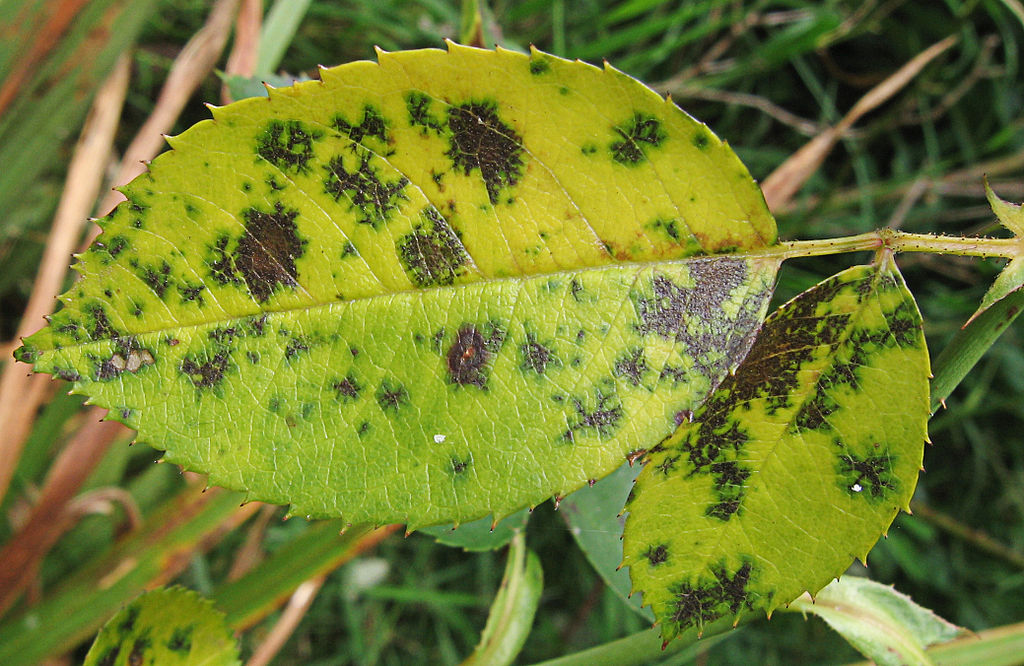Introduction
Black spot of rose is one of the most widespread plant diseases around the world. The disease is caused by the fungus Diplocarpon rosae. Black spot infections seldom kill the host. However, persistent infection can result in a general decline in plant vigor. Extensive defoliation may occur, with fewer blooms produced as the infection advances. Black spot of rose is most active during cool periods with damp weather. Extreme heat during summer will limit the progression of the disease.
Distribution & Habitat
Black rot of rose occurs globally, wherever susceptible plants are present.
Hosts
Black spot infects plants in the rose family.
Disease Cycle
The fungus overwinters in diseased canes and fallen leaves. In early spring, when conditions are sufficiently moist, fruiting bodies that have formed on the infected plant materials rupture, and expel fungal spores into the air. The spores are disseminated by the wind or splashes of rain to nearby rose plants, where they initiate new infections. The spores make contact with the leaves and canes of susceptible rose plants, and proceed to germinate for seven hours. Once the fungus has become established, it rapidly expands within the infected plant material. Black lesions form on the infected leaves, giving rise to fruiting bodies called acervuli, which produce spores that are spread to new tissue.
Symptoms of Infection
Infected leaves will develop black spots, particularly on the upper leaf surface. These black spots may extend up to ½ inch in diameter. Infected leaves will generally have fringed borders. As the infection deepens, the leaves become discolored, turning a pale yellow. Eventually, the leaves may be prematurely shed. Infected leaves may be shed prior to discoloration. Occasionally, infected leaves may remain attached to the host. If closely inspected, miniscule fruiting bodies can be observed protruding outward from the center of the spots. The dark fruiting bodies produce asexual spores called conidia, which cause the black spot infections.
Management
- To minimize overwintering of the fungus, rake and dispose of all discarded leaves in fall.
- Prune out infected leaves, canes, and stems as soon as they become apparent. When possible, prune during dry periods to prevent additional infections from occurring. Diseased plant material may be burned or buried.
- Routinely prune rose plants to improve air circulation, and facilitate a rapid drying of the foliage.
- When planting, select varieties of rose that exhibit an increased resistance to black spot. Resistant cultivars include ‘Bonica’, ‘Carefree Beauty’, ‘Coronado’, ‘Fortyniner’, ‘Grand Opera’, and ‘Simplicity’.
- To limit the disease, grow roses in locations that are exposed to abundant sunlight.
- To allow for proper air circulation, avoid creating dense plantings.
- Maintain plants through sound cultural practices. Apply a layer of organic mulch around rose plants to improve soil quality, moderate soil temperature, and retain soil moisture.
- Ensure that rose plants are sufficiently watered, especially during periods of extended drought.
- Adjust irrigation systems to avoid drenching susceptible foliage.
- Registered fungicides may be applied to the leaves to control the disease. Fungicidal applications will not cure the infected leaves, but if utilized frequently, they can stave off infection of new leaves. Applications should begin in early spring, with subsequent applications performed at 7 to 14 day intervals.
Additional Resources:


